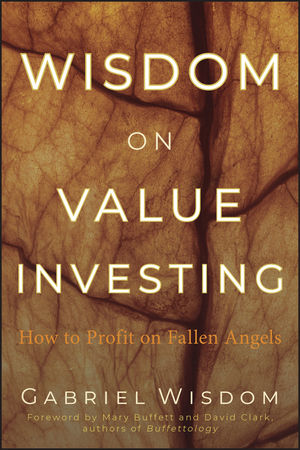Wisdom on Value Investing: How to Profit on Fallen AngelsISBN: 978-0-470-45730-6
Hardcover
208 pages
October 2009
 This is a Print-on-Demand title. It will be printed specifically to fill your order. Please allow an additional 10-15 days delivery time. The book is not returnable.
|
||||||
Connect with Wiley Publicity
Warren Buffet’s value investing mantra is exemplified by his following statements: “You can’t buy what is popular and do well” and “The dumbest reason in the world to buy a stock is because it's going up.” The “everybody’s doing it” philosophy just doesn’t cut it in the investing world. While some investors get caught up in the security of knowing other people are buying or selling the same stock as them, this strategy will not lead to significant profit, or worse, may result in staggering losses.
In WISDOM ON VALUE INVESTING: How to Profit on Fallen Angels (Wiley; October 2009; $27.95; 978-0-470-45730-6; Hardcover), seasoned investment adviser and popular radio host Gabriel Wisdom offers his own insights and guidelines for investors at any level, from beginners and novices to the experienced. Wisdom’s winning strategies stem from his golden rule and the number one trait of all successful investors: “Buy stocks (or whatever) when everyone else is panicking, and to sell when others are overly optimistic.” Wisdom states, “Panic is the overriding instinct that causes otherwise solid stocks and bonds to suddenly go on sale. You see it all the time. People want out after a meltdown. They can’t take the pain and uncertainty, so instead of looking beyond the calamity, they bolt after the annihilation, not before it. This attitude can provide one of the greatest opportunities you may ever have for increasing your wealth.” While this strategy can seem “deceptively simple,” Wisdom’s counterintuitive strategies are harder to adopt than they appear. To resist the urge to follow the herd, Wisdom introduces his successful investing game plan for a high potential return on investment—the Fallen Angels approach.
Part classic value investing and part behavioral finance, this approach involves identifying a stock or commodity whose price has declined to a level below the securities’ underlying, intrinsic value and then closely scrutinizing whether the entity’s fundamentals are likely to propel it to future revenue and earnings growth. Stock prices for financially viable companies can be devastated by the effects of the business cycle, one-time calamities, or widespread panic. There is always a sale or a bargain; still, investors need to know what they are looking for in order to differentiate between fallen angels, fall-ing angels, and the rightfully and unlikely to rise fallen stocks. As Wisdom attests, “If you have a system for determining what to buy, when to buy it, and when to sell it, you’re already ahead of most investors.”
After providing investor traits, tips, tricks, checklists, terms and formulas, Wisdom presents his three-step approach to investing in Fallen Angels.
Search for undervalued, excellent companies: Wisdom outlines the questions every investor should ask themselves about the company before investing—covering history, revenues, earnings, PEG ratio, ROE, cash flows, liquidity, ratios, intrinsic value, net profit margin comparison, and the company’s management. Discussing the significance of the statistics and numbers, he demonstrates how to navigate Yahoo!Finance to discover the data needed to assess the expected rate of return.
Buy stock in excellent companies at reasonable and below-market prices: Once the numbers are analyzed, readers are able to see the truth worth of a company. Wisdom’s Rule of 72 and intrinsic value formula aid in determining if the stock is a bargain. To determine how long it would take to double any initial investment, divide 72 by the expected rate of return for a given company. For example, an investment in a company with a 10 percent return will allow us to double our money in 7.2 years. Better yet, estimate the company’s intrinsic worth by dividing the earnings per share by the anticipated rate of return on a CD for instance, possibly 5%. The answer is the intrinsic worth. If this is higher than what the stock is selling for, then that is what investors may suspect is a bargain.
Sell the stock when the stock or the company no longer meets our criteria: Timing is everything when it comes to selling. Wisdom urges investors to “keep a cool head while others are losing theirs, and over the long run, you should increase your wealth…look at the market and the world with a sense of detachment and, most importantly, stick with proven investment principles when times are tough.” That is why he presents professional timing techniques and technical indicators that professional investors use in their daily management of portfolios.
By following this approach, investors will know how to capitalize on value plays where the fundamentals are actually strong, but the "general wisdom" surrounding the security has turned negative. Stocks with the most promise are ones that Wall Street has marked down, without regard to their underlying value. The best opportunities will sell at roughly half off. These kinds of intrinsic value discounts can provide a margin of safety during difficult times, and substantial upside rewards for those investors who find them early enough.
The book has recently been licensed for translation and publication in China in 2010.



